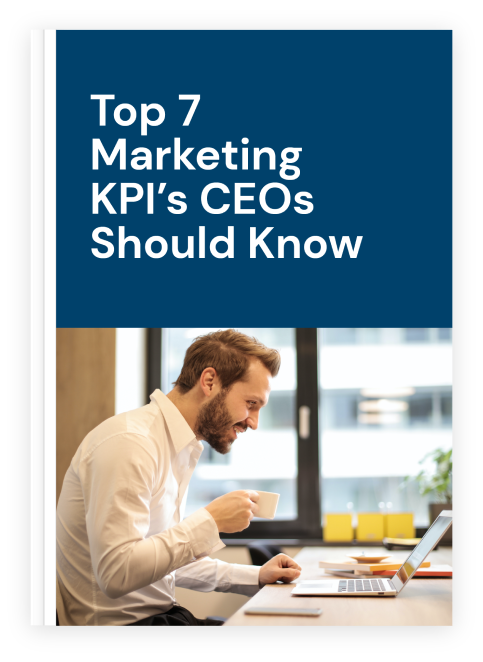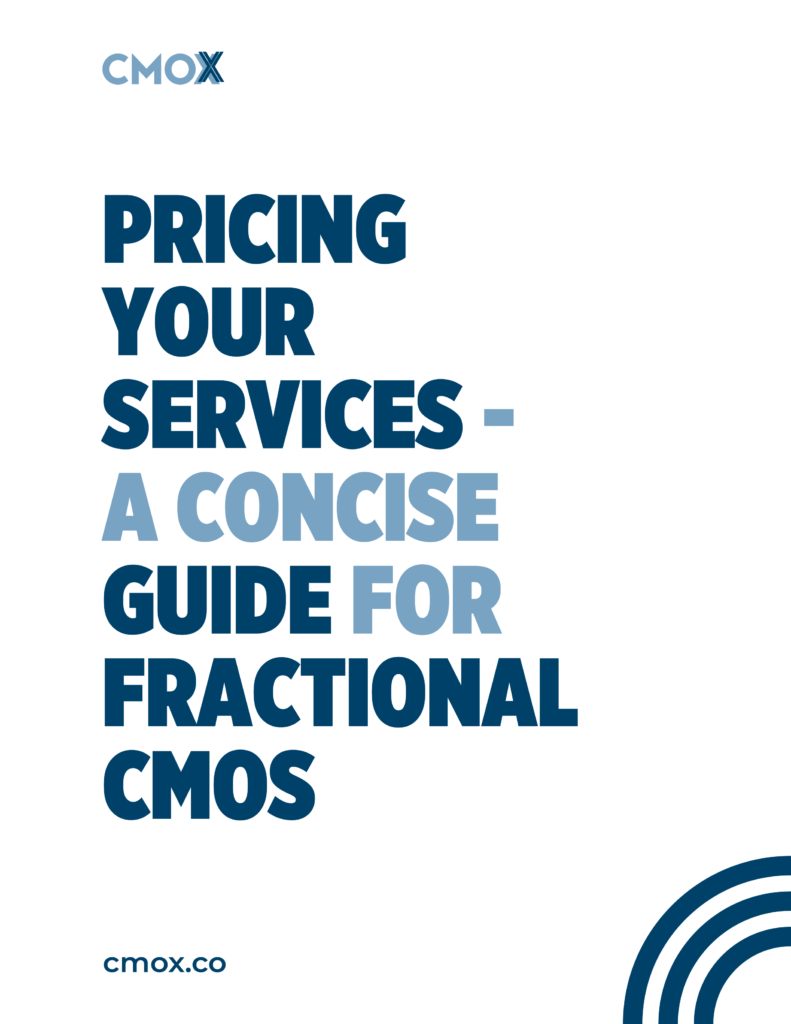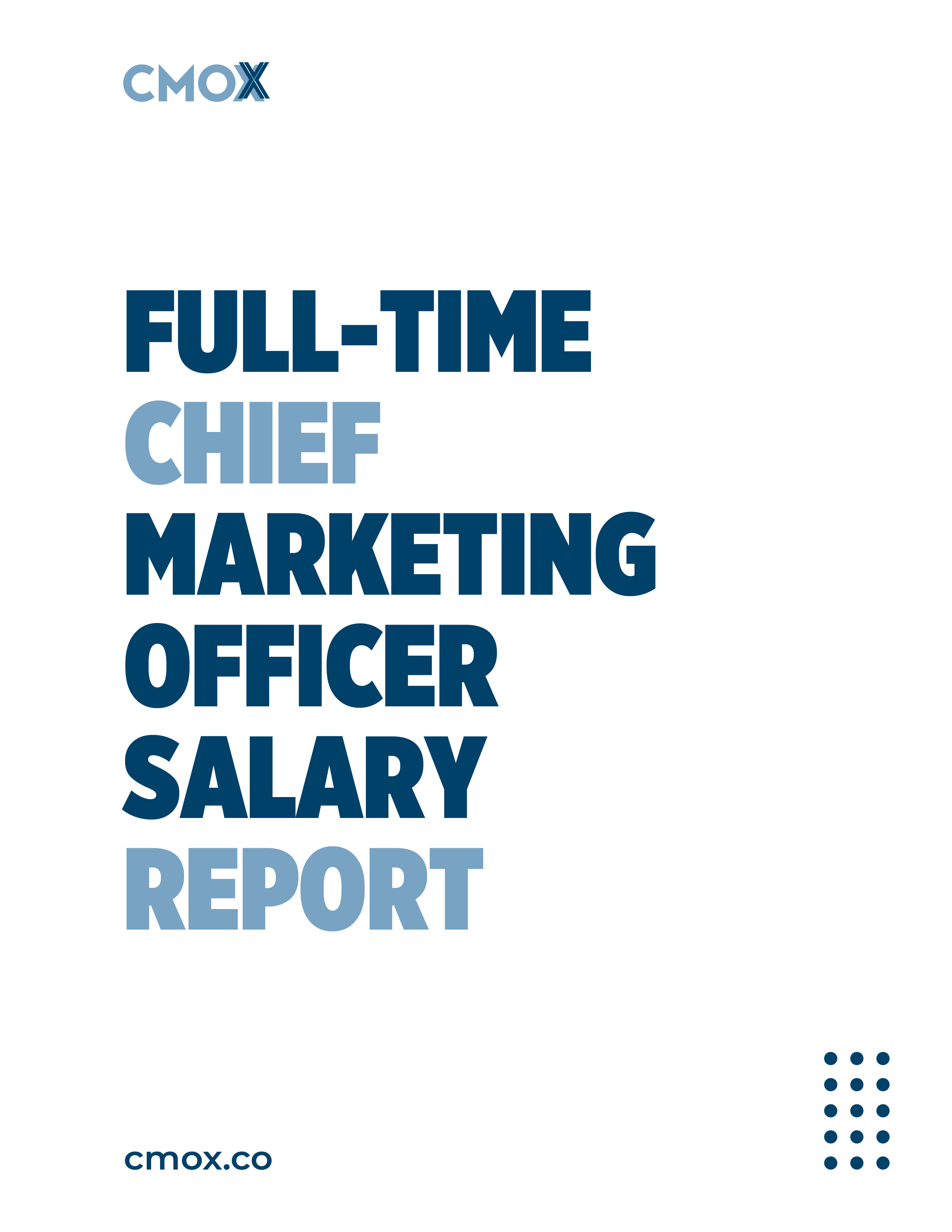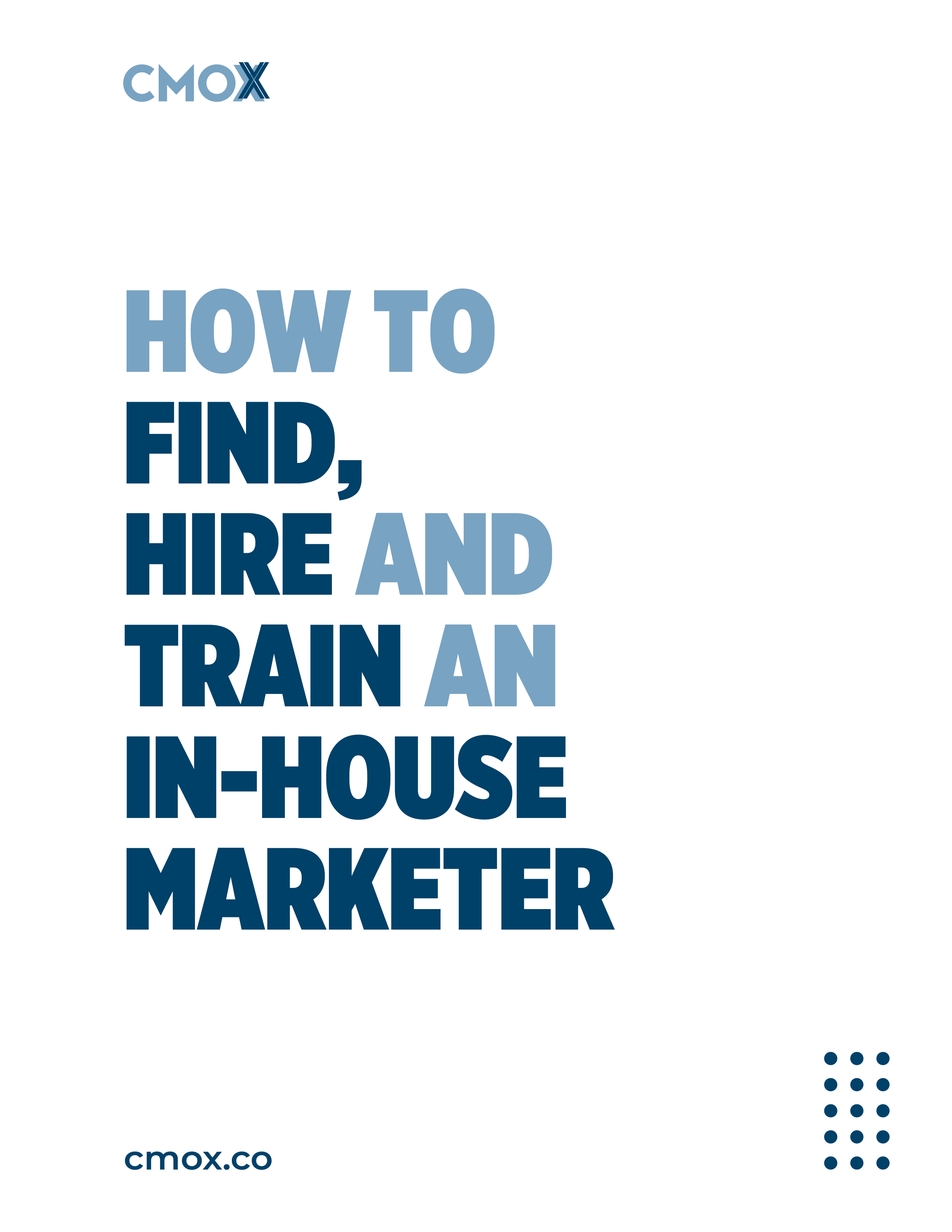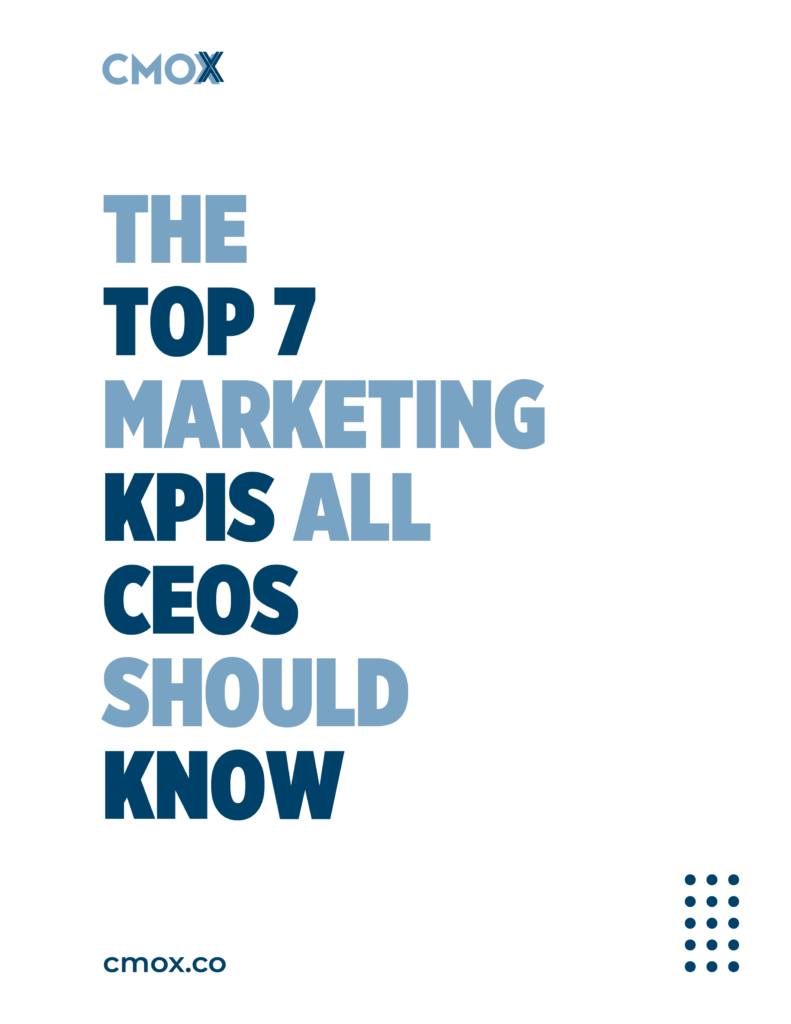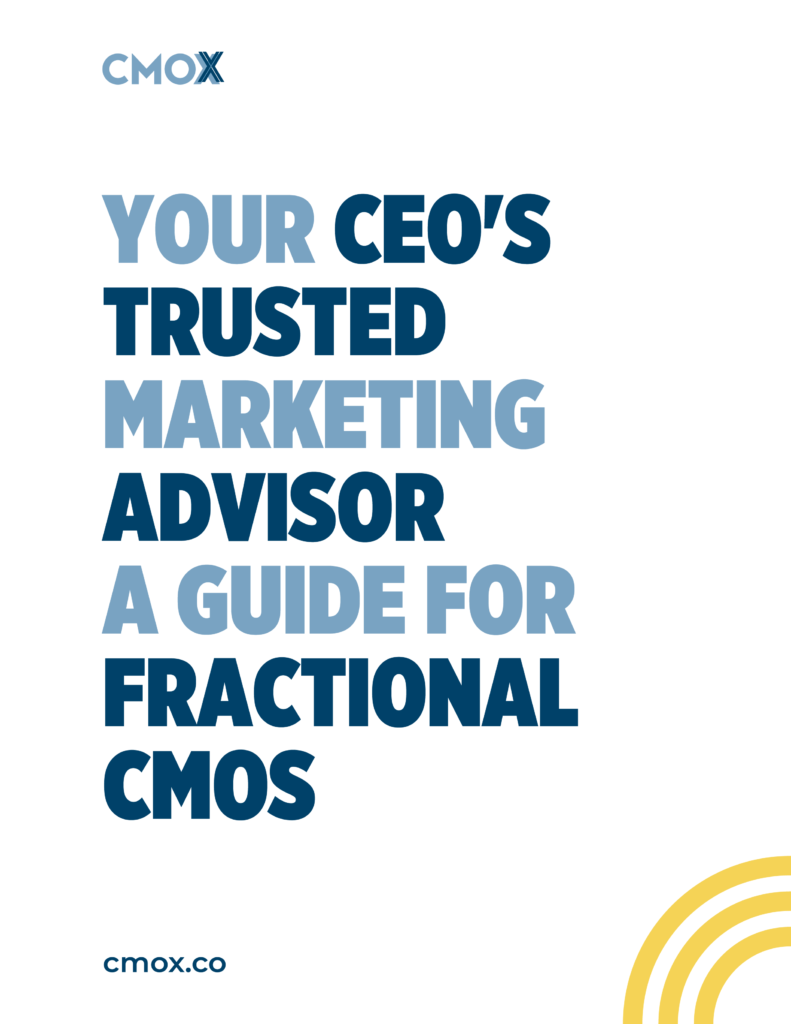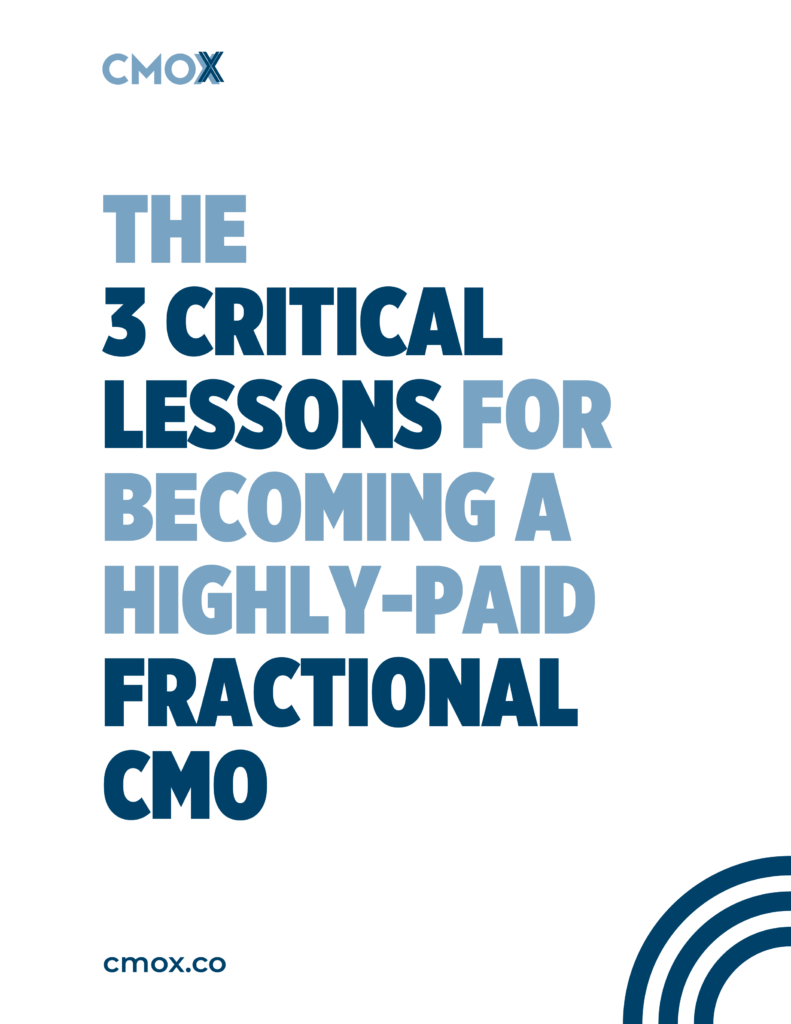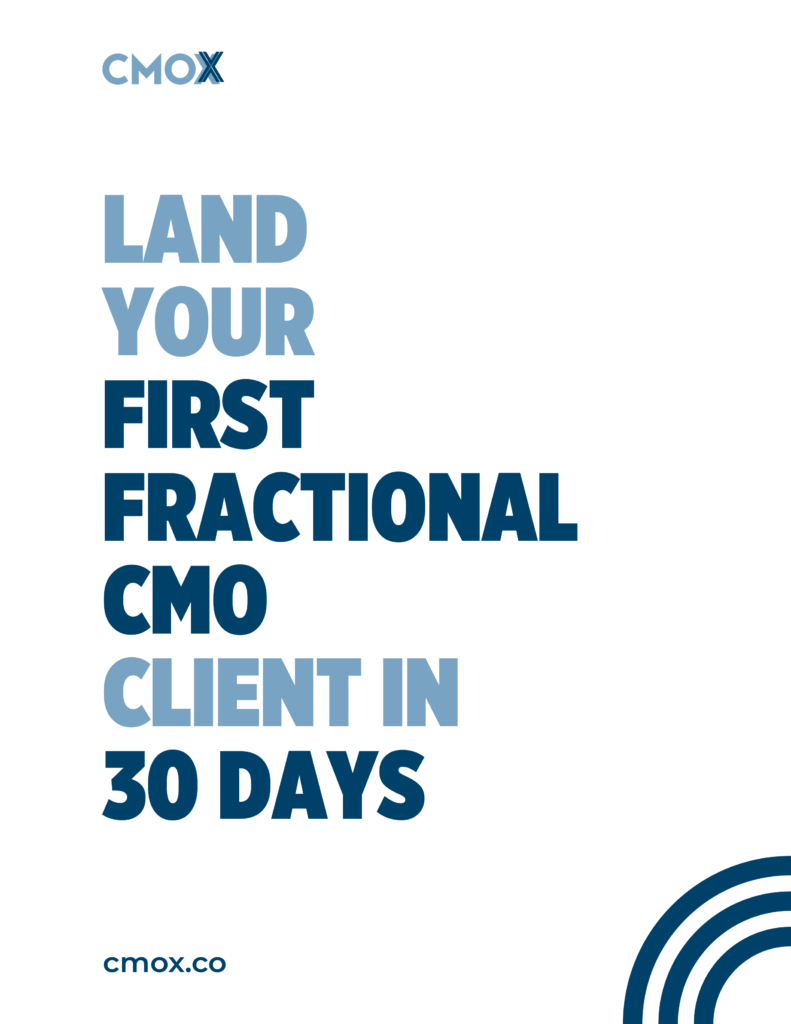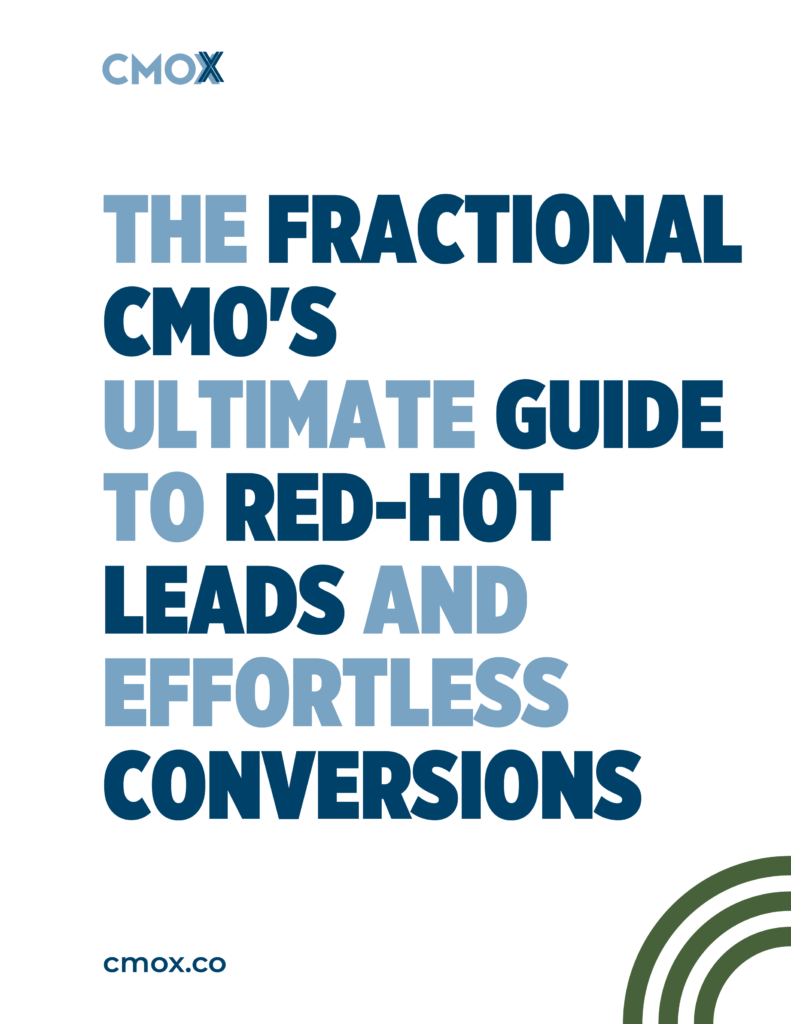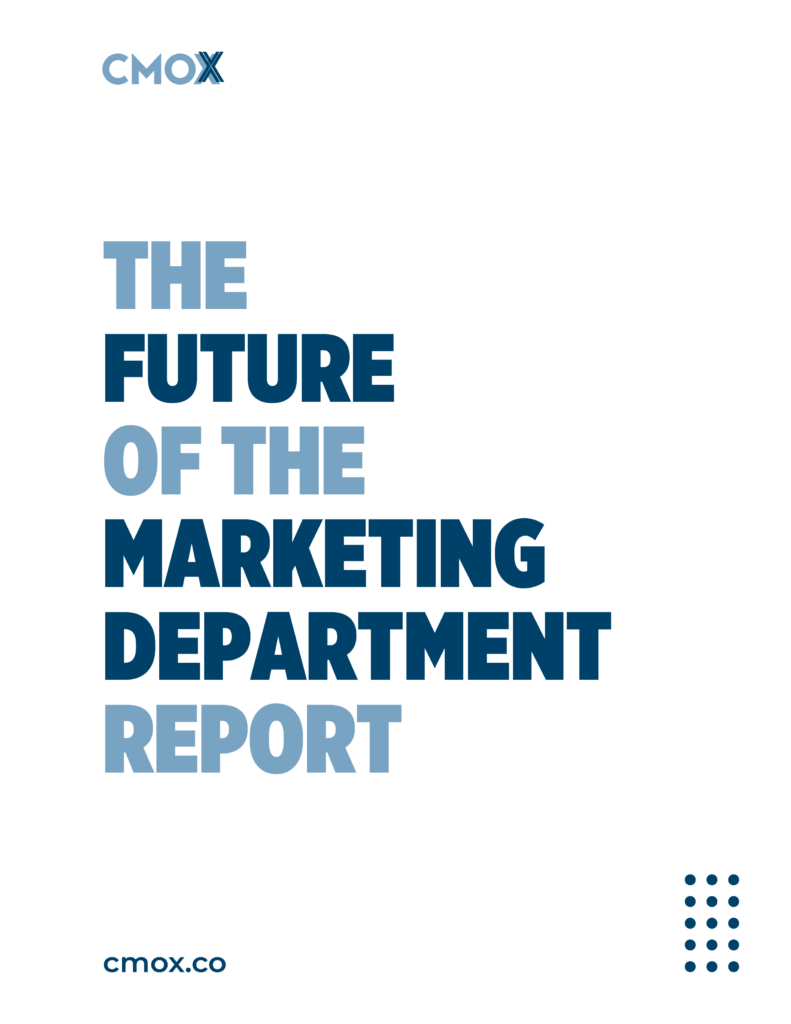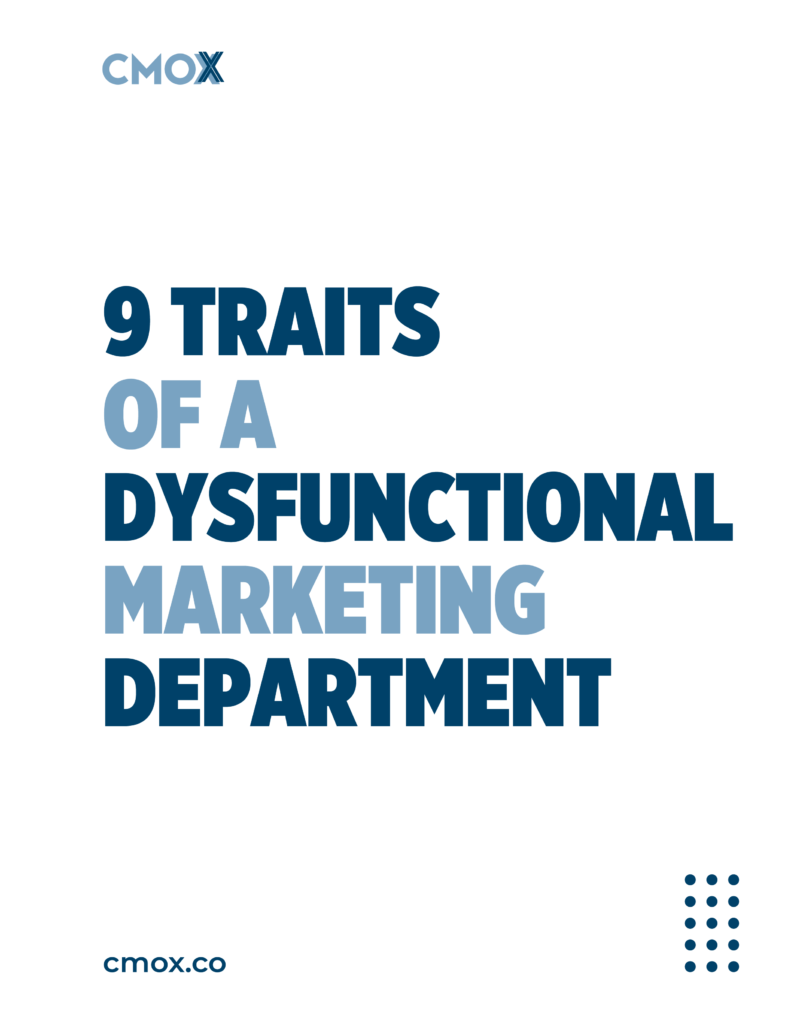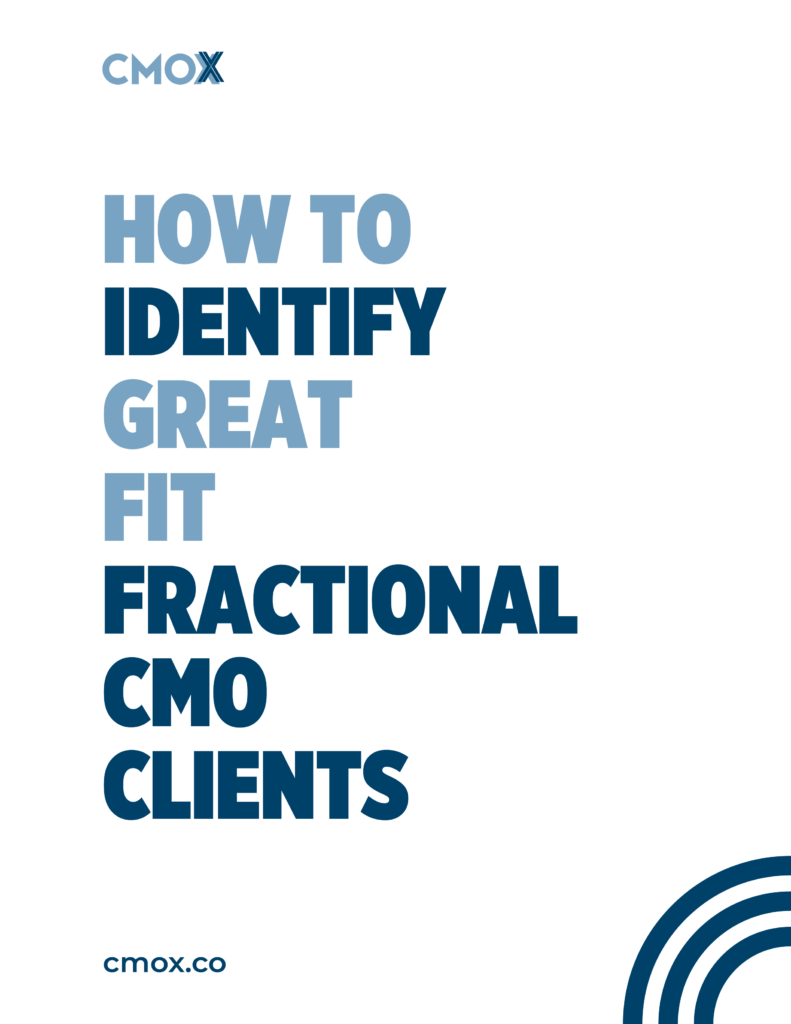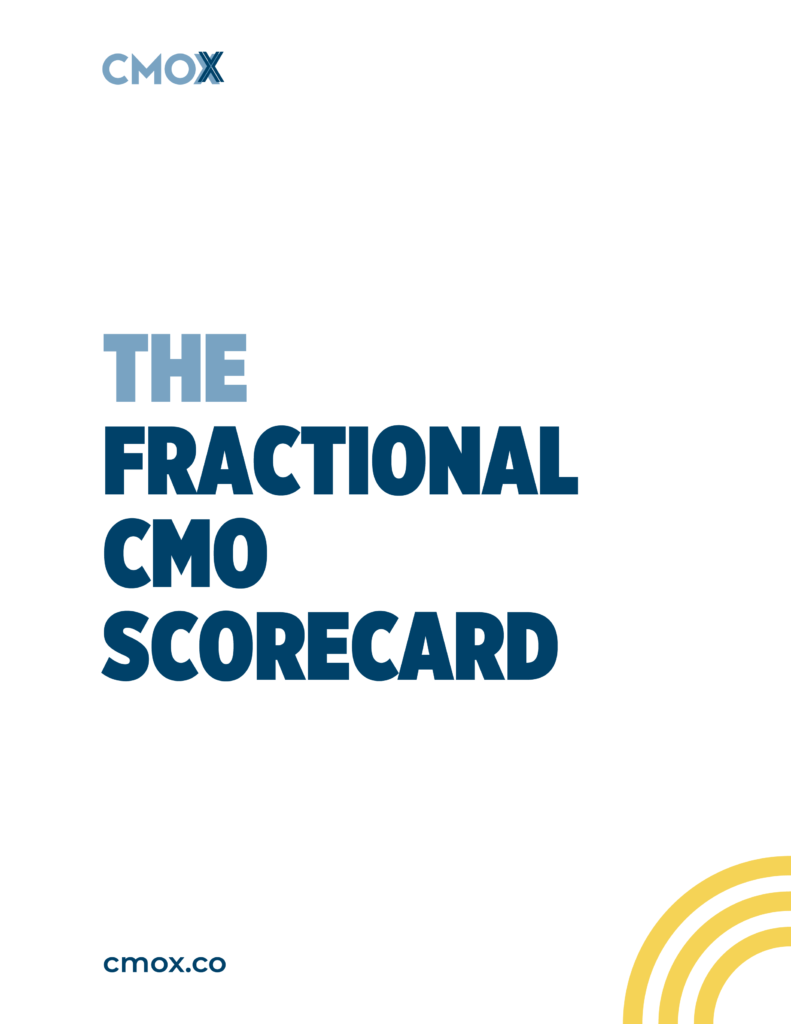Ep #87: How to Shrink a Full Time Marketing Role into a Fractional CMO Size

Struggling with time management as a fractional CMO? Casey tackles the essential mindset shift to streamline your work, increase efficiency, and maximize your impact. Learn how to set clear boundaries, structure your clients into manageable frameworks, and build a scalable, high-value fractional CMO career. If you're ready to work smarter, not harder, this episode is packed with insights to help you take control and thrive.

Episode highlights:
Struggling with time management as a fractional CMO? Casey tackles the essential mindset shift to streamline your work, increase efficiency, and maximize your impact. Learn how to set clear boundaries, structure your clients into manageable frameworks, and build a scalable, high-value fractional CMO career. If you’re ready to work smarter, not harder, this episode is packed with insights to help you take control and thrive.
Here’s what we talked about:
- Overcoming time drain with clients
- Setting boundaries and structure
- Quarterly planning for leadership
- Using scorecards to track key metrics
- Evaluating vendors effectively
- The power of SOPs for scaling
- Managing CEO expectations
- Enforcing personal boundaries
Transcript:
00:00:00 Casey: In this episode, I’m talking to anyone who currently is a fractional CMO gig, and they’re just finding that it’s taking too much time, that they’re not having the authority that they want, that they wanna just figure out how to transform their client so they can kind of put them into a box, keep them as a fractional CMO client, and then go win other clients. Before you can solve or bringing in more money, you first have to take the clients that you have and solve for time with them. Limit the time that you work with them so that you have more space. If that sounds like something that you could use, stick around for this episode.
00:00:32 Casey: Marketers of the world, why do we work hard to solve small problems? Why do we reinvent ourselves and our clients over and over? And why are we giving away marketing strategy for free? With advancements in AI, we’re all seeing the marketing department shrink from the bottom up. And companies need you to serve them as their fractional chief marketing officer.
00:00:56 Casey: It’s time to solve bigger problems and bring home a bigger paycheck. It’s time to create the lifestyle we deserve and to make a greater impact. This is the Fractional CMO Show and I’m Casey Stanton. Join me as we explore this growing industry and learn to solve bigger problems as marketing leaders. The Fractional CMO Show is sponsored by CMOX, the number one company to teach you how to attract, convert and serve high paying fractional CMO clients on your terms.
00:01:29 Casey: Hey, welcome back. So let’s just get right into it. If you’re currently working with a client, a company, and you’re working in some kind of marketing capacity, like you’re the CMO or you’re the VP of Marketing or the Marketing Manager, Marketing Director, or you’re the fractional CMO or the marketing consultant or something else, and you’re just finding that you’re spending a lot of time with the company. Before you can go win other clients, you have to take that time and like squish it into a smaller box. You have to fit them into something that’s a little bit more manageable for you so that you can have time to prospect and win new clients and then service the clients.
00:02:07 Casey: And this is a really good thing to do, especially if you’re working full-time and you’re like, I wanna leave my full-time job, but I’m working 40, 50, 60 hours a week in my full-time gig. How can I leave my full-time gig and still like how- like when can I leave my full-time gig? When am I gonna be able to finally leave? It’s hard for me to build a business on the side if I’m working so much. So solve for doing a better job in less time.
00:02:33 Casey: I wanna be very, very clear. Like this is the dad in me, right? Do not cut corners and deliver a poor quality product. That is not the solution. Like Jim Rohn said, don’t wish it were easier, just wish that you were better. That’s what I want you to do. I want you to get better at what you do so you can deliver a world-class outcome for your clients as their CMO, but I want you to do it in a way that supports you to be able to take on additional clients.
00:03:00 Casey: So the big idea here is that most marketing departments help most companies don’t run on any kind of cadence with real deadlines. There’s a deadline of like, get this done by Friday. And like, that’s a lot of micromanaging to make that stuff happen. I want as the CMO, I want as the business owner to have quarterly outcomes.
00:03:20 Casey: I really like the Entrepreneur operating System. It’s known as EOS. There’s great books on it like Traction or What the Heck is EOS. Geno Wickman is the author of those books. And I like the EOS approach. I think it’s a smart approach to business. It’s not the only one. Ryan Dice at Digital Marketer, he’s got Scalable. That’s another great approach. There’s other ways that you can run a business too. But generally this idea of breaking things into quarters just makes sense.
00:03:51 Casey: So the first thing that you have to have with your client, no matter what they are, if they’re a fractional CMO engagement or if they’re a consulting client or if they’re your employer or whatever, you have to have fiscal quarters that you’re focused on. So first define the quarter. And if this episode comes out, as I hope it will, in like late February 2025, here’s what I want you to do.
00:04:13 Casey: Right now, if you don’t have any quarters set, add to your calendar a quarter. I’m gonna look at the calendar to figure out the right time. So March 31st is a Monday. You don’t wanna build your quarterly plan on the last day. That’s weird. So go book a call with your client or with your team or whoever it is for March 19th or 20th and say, hey guys, we’re doing quarterly planning. We’re doing Q2 planning. Just book that in the calendar and tell everyone.
00:04:39 Casey: First, let me tell you that is an authoritative move. That is the move of someone who is like considering the future, who’s thinking ahead, right? Who’s like building a plan for the company. That’s you. I love doing this too, when like there’s someone over you. You’ve got like a CRO or a head of growth or the CEO who usually does this stuff, but you just did it anyways. You’re like, I’m not looking for anyone to like give me permission. I’m just gonna book it. I’m gonna book the appointment. So March 19th, you’re gonna do your quarterly planning.
00:05:08 Casey: Now you gotta build a quarterly plan before you have that meeting. Your quarterly plan needs to think through, where’s the client now? Where do they wanna be? What’s all the stuff to get there? It’s a lot of stuff that we could talk about what’s in the quarterly plan, but listen, doing it the first time, just set up the rigor of it. Think through what you’re thinking, get on the call and say, hey guys, I’ve been working on a quarterly plan. I wanna present some of the ideas that I have. I wanna hear your ideas and let’s formulate an actual plan for the quarter that we can agree to lock into. And come April 1st at 8 AM, everyone is off to the races on.
00:05:39 Casey: So that’s the first thing you have to do is to create the rigor in the department to work in quarters. Huge, so valuable. And again, I don’t care what your title is, just do this. If this doesn’t exist, do it. It’s just like the move of like, what does a badass do? They say, hey, we’re now moving to quarters. And then maybe you just like schedule emails if you need to into the future.
00:06:02 Casey: So this is done for the next two years, or you add a calendar event at the end of the second month of each quarter to schedule the next quarterly plan, like whatever you want to do. Schedule the rest of the year and quarterly plans right now, you can do that if you want. But you have to be the person that creates the structure for the quarterly plan, that the quarterly plan exists that you operate inside of a quarter.
00:06:21 Casey: And then from there, you have to have numbers, you have to know what numbers matter the most to the client. If I’m the fractional CMO, or the CMO, or the business owner, whatever, I’m not going to spend my whole life just like focusing on the thing. I’m going to spend a part of my life. This part of my life is for health and fitness and spirituality and my family and scrolling endlessly on TikTok and Reddit, right? I don’t do TikTok, but I definitely do Reddit.
00:06:47 Casey: So you need to have an ability to like get into it quickly. Like how do you get into it quickly? How do you get your mind into the problems of the business and know the status of things as quickly as possible? And the answer is simple. It’s just data. You need data. You need a scorecard. And the scorecard is going to say the things that actually matter to you. Leads, MQLs, SQLs, calls booked, quality of the calls, closes, demos booked, revenue collected, pipeline.
00:07:17 Casey: What else do you care about? Cost per click, impressions, cost for impressions like the CPM, other different ad platforms. What are you looking for? Conversion rate on landing pages, email open rates, total email sent. There’s data that you need. You gotta come up with all that stuff. I’ve got a sample scorecard you can grab inside the fractional CMO community. That’s at cmox.com/community. It’s our Facebook group. Once you join, you’ll find one of the posts. It’s one of like the most popular to get the scorecard and you can just grab the scorecard. That’s a template to get you started.
00:07:49 Casey: So you want a scorecard that has all this data in there. Awesome. And then if you’re the CMO, you gotta be like looking at all the vendors, like who’s doing what, and you have to evaluate them. So many vendors just try to talk too much and they don’t get enough done. That’s my frustration with them.
00:08:07 Casey: Rarely do have I worked with vendors who are like bad people. Mostly they’re like really smart technical marketers who just don’t understand how business works. And your job is to like evaluate like, are they the right person for the job? Do they get it? What they say in EOS is do they get it? Do they want it? Do they have capacity for it? They call that the GWC, get it, want it, capacity.
00:08:32 Casey: Some people get it, they want it, but like they don’t have capacity. Like they’re, they don’t have time because it’s an agency and they have 20 clients that they’re servicing that week and there’s just no time for you. Or maybe they don’t have capacity like the mental capacity. I always feel kind of like a jerk when I say this, but listen, there’s a bell curve for intelligence and some people are on the lower side of the bell curve. That’s just how it is. And sometimes you’re working with someone and you’re like, maybe they’re not the smartest person and like maybe they’re not the right person for the team. So you have to evaluate that stuff. Do they get it? Do they want it? Do they have the capacity for it? The time, the mental capacity, whatever.
00:09:06 Casey: You have these people doing things. You’re evaluating them. Are they doing things that actually matter to the business? Are they driving clicks? Or are they getting leads that turn to MQLs and SQLs and ultimately to sales and revenue in the fastest way possible that decreases the cash conversion cycle? Or are they just getting leads? Are they just getting clicks? Are they just reporting on the data from Facebook, but never actually looking at the CRM and seeing if anything happens with the leads?
00:09:31 Casey: SEO. My favorite thing to hear on SEO is when someone says, yeah, so we moved up from position 44 on this keyword to 42 on that one. We moved from position 60 to 59. And this one fell by three spots. What? Like, that’s just so awful. Like, it’s the worst thing to hear in SEO. All I care about in SEO is I’m so simple-minded. What are my keywords for the company, right? I want three keywords, five keywords, whatever. And I just want to dominate them. What’s our position? What’s our plan to get to position one? How long is it going to take?
00:10:03 Casey: SEO people will say, and if you’re listening and you’re an SEO, like you’re going to complain maybe, I get it. They’re going to say things like, it’s always different. The ball’s moving. Like things change all the time. Like, I get it. But still there should be a timeline that we can agree to like, hey, listen, you’re not going to get on page one of Google for this really competitive keyword with your brand new domain for at least 12 months but we should still be spending $2,000 a month building up the SEO strategy because my bet is next year, we’ll be able to get on page one. That’s what a CMO needs to hear.
00:10:30 Casey: I don’t need to hear how we move from position 59 to 56. Like that doesn’t matter as much. I mean, every week, sure, it’s nice to see it, but really like I wanted to have a committed plan and track that over the course of like quarters and see movement on that. So you want a scorecard that tells you this stuff and your vendors need to be filling up that scorecard on your behalf. So it’s critical to understand your job is not to fill out the scorecard, your job is to review the scorecard that other people filled out and look for inconsistencies, things that you don’t believe, things that don’t make sense, that kind of stuff. Like you’re there to like look for problems.
00:11:06 Casey: You’re a doctor, right? You’re a doctor who just got the chart, walked into the patient’s room and says, hmm, let’s see what’s going on. Flipping through the X-rays, flipping through the blood labs, that’s where you wanna be. You don’t wanna be the person who’s pulling the blood, sticking it in the machines, doing the imaging, all that stuff. You’re like the doctor. That’s how you can get paid the big bucks as a fractional CMO.
00:11:26 Casey: So you want, if you’re inside of a company, you wanna start assigning people like, hey, I need you to put all this data into this scorecard. If you work with multiple agencies, here’s probably what that looks like. Agency analytics from the PPC team, weird SEO analytics from the SEO team, that weird person who’s doing the other advertising in direct mail or whatever, like reports in an email that’s always late. It’s like different places to understand the health of the business. I just want it all dropped back into one scorecard, one Google Sheet, it’s not hard to build, that tells the whole story. That’s it.
00:11:57 Casey: Once you have that one Google Sheet, you can kind of sit back, review it, and see what’s right and what’s wrong, what’s on track and what’s not. And if something’s not on track, like that’s where the focus should be. It shouldn’t be on, hey guys, we’re using blue font here and our brand colors are to use this color blue, not that one. Right, you can like squabble over that stuff.
00:12:16 Casey: Or you can be the more executive person and say, hey guys, I know that’s something that we should talk about, but I’m really concerned about lead volume. Not so much that all of our creatives are perfectly on brand. Can we talk about the lead volume problem? Because it seems to me that we’re misallocating our budget. Boom, you’re solving a bigger problem in that moment. Again, elevates you, takes you to the next level.
00:12:38 Casey: All right, next thing you gotta do is you gotta have SOPs. We’re kind of, I keep an eye on like flu trends, right? Like COVID trends. And they spike obviously during the holidays when everyone’s together and indoors and they kind of drop generally in the warmer months. And that happens with flu A, flu B, norovirus, all that kind of stuff. So like, I’m not overly concerned right now as we’re in the middle of Q2 or Q1 2025, that like we’re gonna see big spikes in people getting sick.
00:13:06 Casey: But I’ll tell you what, in Q4, I just assume half my team’s gonna be out. I just assume it. So if you assume that half your team’s gonna get sick or someone’s having a baby and they’re gonna be out for a mat leave or pat leave or whatever. You gotta have other people cross-trained to do the thing. You can’t have the one person who knows how to do it be gone and then just like the thing doesn’t happen, whatever the thing is.
00:13:29 Casey: So you need to have standard operating procedures, SOPs. And these procedures need to be written by the person who does the thing in such simple terms that you can hire someone who doesn’t really understand the business and they could do the thing. The SOP is critical for the success of the business. You want SOPs to exist because like EOS says, there’s either a no process or the process isn’t followed. Whenever there’s a problem.
00:13:54 Casey: We had a problem. Just this morning inside of the CMOX Accelerator, I recorded a video and it just like wasn’t posted fast enough for me. It was taking a couple days before it got posted after we hosted a live event. And I was like, I don’t know these guys. Do we have a process? And is it being followed or not?
00:14:12 Casey: And what we what we found was we actually didn’t have a clear process. Like our process wasn’t to post the video within 24 hours of it going live. Generally that happened, but it wasn’t agreed upon process. So when it didn’t happen, because the person who tends to do that was just busy on other stuff, they were going to get to it, there was like a misalignment in process. So we didn’t have a process. We created a process, standard operating procedure, done, never going to be an issue again, because the team follows the processes. So that’s how you have to think, is there a process and is the process being followed?
00:14:43 Casey: I was working with a company, we had a sales team, and we had issues where things weren’t getting done from the sales team. And they were coming up with all these excuses and whatever. And I said, Hey, guys, stop. I don’t- like just stop. Do we have a process here? And if we do, is it being followed? And I’m not saying that to be a jerk. It’s just a real question. Do we have a process and is it being followed? And after they kind of like, put their ego in check, right? They’re like, there’s no process.
00:15:08 Casey: And I was like, Okay, that’s on me. I’m asking you guys to deliver on a process that doesn’t exist. Let me create a process. I’ll propose it to you. If we agree to it, then we’re off to the races. They said great. Right? Like my fault, we didn’t have a process. So we create a process. They agree to it. Never was a problem ever again. You want to have processes for this stuff. It’s a process problem or someone not following process. There’s no there’s no other option in that, right? Process, follow the process. Simple. All right.
00:15:35 Casey: So you have some of the stuff that you’re starting to do and you’re kind of being a little bit more executive in your action. You’re being a little bit more of the CMO. So then what do you do to like squeeze your client into a box? Well, here’s a couple things that can happen. I’m gonna guess four things that happen.
00:15:52 Casey: One is that you’re just unable to put your client right now into a box, work less hours with them because you’re still building out this initial system. You’re building up the scorecard. You’re finding good people. You’re replacing some people. You’re building out the SOPs. Like you’re understanding how to build a process and ensure people follow it. Like that takes time. I’m pretty good at it with a new company. Probably take me 60 days before I started to feel kind of a release of those things being in place. Even with a great team, it takes time for old dogs to learn new tricks. So that takes some time, that’s one.
00:16:25 Casey: The second thing is maybe you’re pitch hitting for a bad team. Maybe you’re coming in and saving the day because you said, hey, I want these emails done and someone wrote them and they did a terrible job and it’s on you to make sure that it’s done right. So you’re just like gonna go in and pitch it. You’re doing emergency work. You’re like, man, it’s Thursday at five and I did not think I had to go rewrite all these emails but we’re launching in the morning and I can’t do it tomorrow because I gotta take my kid to school. So I guess I’m writing all the emails for this guy who didn’t do a good job. That happens, right?
00:16:55 Casey: If that happens, what do I do? I replace squeaky wheels. You know that term, the squeaky wheel gets the grease? Sure, in a lot of companies. Not in the companies I work with. The squeaky wheel gets replaced. I bring in a better wheel, a wheel that can do the damn job on time, on budget with great communication. That’s what I’m looking for.
00:17:13 Casey: So if you’re pitching for a bad team, what do you do about it? You gotta like fix the team. You gotta stand up and say, hey guys, this is unacceptable. This isn’t to standards, we’re better than this. That’s why I think most companies need a core value of world-class everything. A lot of companies just don’t have a core value of world class. They have a core value of something soft, like everyone gets along or we’re all in it together or whatever.
00:17:38 Casey: Your core value needs to be like world class everything you like, hey, dude, that’s not really world class. And this has to get out to the client. I need you to work on it tonight, rewrite it, build it better. Show me tomorrow morning. I’m betting on you to get this right. That’s where you want to be. Okay, that’s the level of like, ownership of the outcomes, but also like pushing the team to own their outcomes as well.
00:17:58 Casey: So those are the first two reasons. Again, you’re still building the system. Two is you just have a bad team and you’re doing emergency work. Three is that you’re chasing the whims of the business owner and you might have like limited staff here. And you find that like you’re in this position of like, someone’s gotta do it, so it’s me. So I gotta do it tonight. I used to be this way back at the agency. I used to stay up late working for clients.
00:18:20 Casey: Part of it, if I’m being honest, was just ego. Like no one’s better than Casey. There’s people that were as good as me. Some of them better than me. Certainly we could find people that were better than me. I mean, the agency was kind of small. So it’s not like there weren’t a lot of like, there wasn’t another copywriter at the agency. So like I had to write the copy. But I could have also like raised my hand and said, hey guys, this is outside of what I have capacity for. But I didn’t. I was just like, that’s a great idea. I guess I have to make it happen and then stay up all night and work on it. This is before AI too, right?
00:18:50 Casey: CEOs also, some of them just change their mind all the time. They don’t even remember what they agreed to that morning. And they’re throwing new ideas on you. So you’re like committed to something and like adding on more stuff. And then you have a meeting to like redefine the scope of everything and then they agree to it. And then a week later, the scopes, you know, 50% more stuff is added to the scope. That happens with certain entrepreneurs. How do you stop that? Well, it’s a boundary issue for you.
00:19:18 Casey: But before we talk about your boundaries, let’s instead talk about just the rigor of the quarter. When you start the quarter, so if you do what I say, and you set that meeting for March 19th, and you get everyone on the same page for quarterly planning, and then you’re off to the races come April 1, if your CEO comes to you on April 15th, then they say, hey, we’ve got this new idea I wanna slide in. You say, great, I love the idea. I totally get it. That sounds like a lot of fun, sounds like a good up.
00:19:48 Casey: We’re limited on capacity because we’re booked out for the quarter right now when all these other projects that we agreed to just a couple of weeks ago. I can reshuffle those projects. The question is, which one don’t you want us to do this one, that one or the other one? And they’re like, oh, man, when you say it that way, we can just wait on this project.
00:20:06 Casey: You’re like, great, I can put it in the icebox. We can check in on it when we do Q3 planning in a couple of months. And if it still is important, then that can be the first project that we say yes to. How does that sound? CEOs like, great. Ideas out of my mind. You know, I don’t have to think about it anymore. I’ve cascaded it. It’s someone else’s responsible for it. And it’s getting prioritized appropriately. That’s right where you wanna be.
00:20:27 Casey: So we can put our CEOs into a box if we create structure for their ideas to get reviewed, prioritized and executed within or rejected. Sometimes the CEO throws an idea at me and I say, candidly, it’s a bad idea for these reasons. I like your energy on it. I like where you’re going, but that won’t work for these reasons. I think we can maybe do this instead, or honestly, that’s something that we tried before, didn’t work, and I don’t really wanna try something like that again until we do these other campaigns first.
00:20:54 Casey: You wanna know everything that has to happen in the order it has to happen for like the next couple quarters generally. Like I know exactly what has to happen for all of my fractional CMO clients in Q1, and I’ve got some pretty good ideas of what I wanna see happen in Q2, and I’ve got a list for each of them of like, these are the things that I want to make sure that we talk about for Q2. And like Q3, I have like an inkling and come Q4, honestly, I don’t even know what we’ll need at that point. Right?
00:21:20 Casey: I just can’t think that far down the road, because there’s just like so much building that has to happen. If you don’t know, I took on fractional CMO clients kind of starting in November. So for like the last three months, I’ve been adding about a new client or so a month, just to kind of get back in the game and have some fun and the first month is always the hardest month because you’re like figuring everything out. And then like the second month can be kind of tricky, too. But once you get into the third month, things just start to get more aligned, and you kind of can calm down a bit and everyone knows what they’re doing. And they’re focusing on the most important stuff and you get a good team.
00:21:53 Casey: Okay, so those are three big things. Let me hit those three again. One, you’re still building everything the scorecard finding good people, etc. Two, you’re pitch hitting for a bad team and you’re doing emergency work. Three is that you’re chasing the whims of the entrepreneur and saying like, somebody’s got to do it, so it’s got to be you. That’s what’s taking your time from 10, 15, 20 hours a week and making it 40, 50, 60 hours a week.
00:22:15 Casey: Number four is a big one, which is just like the, you can’t say no. You can’t say no for whatever reason. You don’t want to piss off the entrepreneur because they’re kind of spicy and they might fire you and you need this money because you’re the sole income earner. I get it, okay? That’s big. I definitely have had that anxiety too. Like don’t want to like push too hard, don’t want to say no. No, don’t want to have a boundary because if they say, well, I’ll find someone else to do it, then shoot, how am I going to find work? How am I going to pay rent? You know, how am I going to go on a vacation? How am I going to, you know, buy eggs, whatever that could happen.
00:22:47 Casey: Other times we say that we can’t say no more because of like a fear of what we don’t even know. It’s not like I’m working with someone who’s kind of like a jerk of an entrepreneur who’s likely to fire me. And they’re the kind of person who fires people on the spot on calls, those people exist. But maybe it’s just like, I’m afraid of that general thing happening. And it’s a story that you’re telling yourself. And maybe you’re kind of going down like a negative brain train around just all the negative stuff that could happen. That might be true for you too. That’s a bit anxiety, right?
00:23:16 Casey: Another one is just that you have a hard time standing up for yourself and your boundaries. Like you’ll do whatever the client wants, but when it comes time to take care of yourself, you’re like a little weak on your own boundaries. And that’s probably true, not just at work, but like in your whole life. Maybe with your parents, maybe with your siblings, maybe with your friends, maybe with your roommates, your past roommates. There’s like a story in your life of like, people kind of taking advantage of you, or you just kind of like being a helper and taking care of other people instead of taking care of yourself. If that’s true, that makes sense. That’s a very normal thing to happen.
00:23:50 Casey: I definitely have experience in my life around that. And, you know, a little bit of therapy later. When I say a little, I mean like years of therapy later. I’ve kind of gotten clear on a lot of that stuff. And I realized, you know, here’s the answer. It’s like, when I take care of myself and I have boundaries, I can produce a better work product for the fewer things that I’m committed to than stretch myself thin on too many things and just like deliver kind of a crappy work product on everything. I would rather be world-class in three things, a quarter, than mediocre in nine, right?
00:24:25 Casey: Sometimes we do have to take on some emergency work because something happened, big opportunity, the website went down, whatever. The agency got acquired and they tripled their rates and you gotta fire them, like whatever happens. Like sometimes that’s gonna happen and you have to be there to support that emergency. I can think of off the top of my head, two times that I’ve actually had to like work real emergencies as a fractional CMO because I’ve like built a base of things that’s like really calm and supportive.
00:24:52 Casey: So if you’re feeling like you’re pulled into things and you can’t say no, it’s probably a boundary thing with you and it’s a reflection thing that you have to have. Like where are my boundaries rigid? Where are they porous and where are they kind and loving? Like where am I taking care of you and me at the same time? That’s the boundary that you wanna aim for. Some great people that can help you with that. Jayson Gaddis, one of my favorites, he’s got relationship school. I would just look up his podcast and search for boundaries.
00:25:21 Casey: Terri Cole, if you’re looking for a woman to talk about this, because she kind of understands that whole side of the world a little bit differently than Jayson does. Check her out. She’s got great stuff on boundaries. They did a call together a couple years ago, which was good. Melissa Urban from Whole30. She’s got The Book of Boundaries. I think, I mean, she’s one of my favorite content creators just from her authenticity. I think she’s just one of the best.
00:25:44 Casey: So that’s some places that you can go. You know, you can maybe go work with a therapist. If you do like a Gottman therapist, I think that that’s a cool flavor. Go with a relationship coach with relationship school, whatever you want to do, but like get into this thing because it’s not a them problem. It’s a you problem and you’re blaming it on them. I’m going to give you one quick example on this.
00:26:04 Casey: So a few years ago, I was working as a fractional CMO with a guy and it was just kind of a tenuous relationship. It was tense. I didn’t love it. So ultimately I like exited the relationship. Fortunately, you know, like it was it was still a good exit, but like I worked myself out so that I didn’t have to work there anymore. I was like, that guy was kind of a jerk. And then the next client I picked up was kind of a jerk too. And they were kind of in the same age range. They were the same generation. Yeah, they’re like, kind of, they had like a lot of similarities.
00:26:32 Casey: And I just thought to myself at one point, I was like, wow, is it those guys were both like jerks or they didn’t respect my boundaries or whatever? Was that it? Or was it me? Was it me who didn’t establish a boundary, clarify the boundary, hold the boundary despite them maybe getting frustrated or, you know, them wanting me to jump on a project on Friday night or whatever? Was it a me thing or was it a them thing? And I realized it was totally not a them thing. It was a me thing. It was all about me not being able to hold boundaries to protect myself.
00:27:03 Casey: So that was a really big eye opening experience for me. And it’s changed the way that I approach things. If you want to get into this, I really like this kind of talk. There’s a great book called Already Free by Bruce Tift. Beautiful book, like one of my favorite personal development books. And in it, he says that we have cycles in life. And the, let’s say the Western thought is that I can go from where I am to like some solution where I never have the problem again, right? Like I have a boundary issue now, I have a hard time holding boundaries for myself, and I wanna move to a place where I don’t have that problem anymore.
00:27:39 Casey: And his suggestion is like that version of, I’m here and I have to go there, isn’t it. And then there’s the kind of the Eastern approach that he talks about. And in this Eastern approach, he talks about that you keep seeing the same pattern over and over again. Like it kind of, it’s like reborn, right? Like this boundary issue keeps coming back over and over again. And Bruce Tiff takes both of those and pushes them together and his visual is a spiral staircase.
00:28:09 Casey: So you do go around and see your same patterns around how you react to certain environments and the boundaries that you may or may not have and how you wish for more and that you’re not taking care of yourself. Like maybe that exists, but also you get the elevation and that elevation is the spiral staircase where you start to see yourself growing from it yet still experiencing it. So the belief that there’ll be some cessation, like you’ll stop having issues with boundaries forever more is false.
00:28:38 Casey: And the truth is that you’ll get better at identifying them, you’ll get better at your self talk, and they still might be challenging sometimes. And that’s just something you’re going to deal with for the rest of your life. I mean, there’s there’s so much to say about entrepreneurship here. Being like, one of the ultimate vessels to self understanding, because you’re around a bunch of people and the problems that they all have are just reflections of you. You know, it’s anything that I hate about someone else is something I’ve disowned in myself.
00:29:06 Casey: So be aware of that. Be aware that boundaries are a major reason that you’re taking on extra work. Couple that with the prerogative of the CEO, which is to get the most amount of labor possible out of the team, right? It’s like, what is my job as the CEO of CMOX? It’s to get as much labor out as possible for my team. To not want to hire more people and just fill everybody up until they tell me that they’re too full. Like their job is to tell me when they’re too full because I don’t monitor like very closely how many hours they’re working and all that stuff. I need them to tell me. And if they never tell me, I’ll never know.
00:29:43 Casey: But my prerogative is to grow the business. And I just like am not naturally going to know everyone’s capacity. I just can’t. There’s just too many people. So I’ve heard fractional CMOs inside the Accelerator say things like, you know, the CEO doesn’t get how hard I’m working. They don’t care how hard you’re working. That’s the truth. They care about your output. And if you want more, ask for more.
00:30:04 Casey: If it doesn’t work for you, move on. Go find another client, have that optionality. That’s really where you want to be. You want to be in the driver’s seat as the CMO who gets to do the thing for the client and help them out. And then if you need more time, you just maybe ask for a change in the contract or some upside to compensate you for the extra activity or whatever it is.
00:30:28 Casey: We’ve had some CMOs who have doubled their rate for two months or three months because the company just did an acquisition of another company and it’s a bunch of extra work for 60 or 90 days. And then after that, it’s gonna slow back down. So some of the CMOs are like, oh, I’m like afraid to charge more. I’m just gonna overwork and get frustrated and not go out and prospect and get other work and get really dependent on this one client versus maybe like the more self-conscious, more mature CMO who says, okay, as I see what’s coming down the pipe, that’s a lot.
00:31:01 Casey: I gotta double my rate for 60 or 90 days. So I’m just gonna go call the CEO and be like, hey guys, as this stuff’s coming, and I’ve been thinking about it, it’s gonna require this more for me, and I have to do this. Or I need a bigger budget, or I need to hire these three people for this amount of time, or we have to fire this agency and bring this one in. Like there’s kind of like a, I’m in control, I understand what’s happening, and I’m vying for what I need that CEOs need to hear.
00:31:26 Casey: You’re also allowed to say like no to things. The CEO says, Hey, I want to do this. I want to do a trade show and I want you to fly to it and do X, Y, Z. You say, great, I totally get why you want to do that. That doesn’t work for me. I’m happy to make a plan for it and get other team members to go. But you know, that’s not going to work for me to fly. I’m just not going to do that. Like me. Not really eager to fly out to people’s events. I’ll do it if it’s like a fun event and it works in my calendar and works around my family time.
00:31:53 Casey: Man, I’m not eager to be on the road. Shoot. I have no trips like work trips planned right now. And it’s lovely. I get to spend all my time with my family. That’s really where I wanna be. So think about that for you. Think about the boundaries that you’re setting and making sure that you can say no. When you’re saying no from a place of confidence, not like a, like, no, you’re crazy.
00:32:13 Casey: But like, I totally get it, dude. Like, that’s a good idea. I see why you wanna do it. I’m not the person for it. Here’s an alternative way that we could work on it together. Or I need to double my rates, or I need to get flights in a per diem and tack on a $5,000 fee for me to attend the event or whatever the thing is, right? Having an ability to establish your boundaries, then holding those boundaries is critical.
00:32:36 Casey: I’m going to give you one last thing on this before I wrap. So years ago, I worked with a company and just like a really emotionally intelligent company, it was three folks there. And I set in a autoresponder in my GMail inbox on the weekends, it said that I wasn’t available. And I don’t know if I was like cutting out, if I did it every day, you know, like three o’clock or something, or if I just cut out on Fridays. I don’t remember the details, but I had something set up. It says I don’t check my email until, you know, these times. That was probably what it was. Like I checked my emails at like 10 AM and 2 PM every day.
00:33:12 Casey: They saw that and they were like, cool, got it. Like that makes sense. Thanks for letting me know. And then I would send them an email like 8 PM on a Friday. Why? Because like I kinda didn’t do much that Friday. I was out playing, I was having fun. I was just like at home, like kicking back, I got an email, I was checking my email on my phone, I was like, I’ll write back to them. Right? My time, I get to do whatever I want, that’s how I saw it. And I was like, I’m being helpful, instead of waiting till Monday.
00:33:35 Casey: Their feedback to me opened my eyes. They said, Casey, like, we’ve got a question for you. You set this boundary with us, but you’re not holding it. We’re having a hard time trusting you. What? Like that was so shocking to me. The boundary was, I only check my email twice a day. And then I checked it outside of the norm that I stated and I emailed them back and it lost trust. I thought I was overdelivering. I thought I was being helpful, but for them, they just couldn’t believe that I was like trustworthy at that point, because I said something about my own boundary and I went against it. Interesting how they took that. Right or wrong? Very interesting how they took that.
00:34:14 Casey: So think about that with your clients. When you establish a boundary, they see you taking care of yourself. And if you can hold to that boundary then they appreciate it and they get it and they can trust you that when you say you’re going to do something you do it. But on the other hand, if you establish a boundary like I don’t work on Fridays, and then you’re like emailing all day on Fridays, then they don’t believe that you don’t work on Fridays. And then they’re upset with you when it’s three o’clock on Friday, and they email you and they don’t hear back till Monday.
00:34:38 Casey: And you say, but guys, I told you I didn’t work Fridays. They’re like, but you worked the last two Fridays. How did I know that this was the Friday that you actually were going to do the thing he said. So establishing boundaries really means being considerate of others and your time and your capacity. Okay.
00:34:52 Casey: All right. So if you do this right, you’re going to take your work with your client 30, 40 hours a week, let’s say, and you can scrunch it down. And maybe you can scratch it down to 20 hours a week. And then from that 20 you see, okay, I’m doing marketing strategy, marketing leadership for 10. I’m doing copywriting, copy editing and CRM management for 10, right? And then you say, Okay, cool. How do I hire out that 10 that isn’t marketing strategy and leadership? How do I get rid of that stuff?
00:35:20 Casey: Go figure out like actually how to hire that. Go like run job posts, hire that person, get your client to hire them, take that work off your plate. Boom, now all you’re left with is marketing strategy and leadership and you approach the client and say, hey guys, I wanna get paid half of what I’m paid right now. Half of what I’m paid right now, that’s what I’m looking for. And I’m only gonna deliver the stuff that I have been delivering, which is about 10 hours a week. So you cut your rate in half, cut your hours into a quarter, boom.
00:35:45 Casey: Now you’re on track to being able to double your income if you wanted to. If you brought in three other clients, you could double your income. Just like that, double your income. Just doing marketing strategy and leadership, never having to roll up your sleeves and do the actual implementation. It’s a powerful place to be, and it’s possible for you to get there. You just have to be committed to it. You gotta be the kind of person who makes this stuff happen.
00:36:08 Casey: And again, I’m gonna come full circle here. At the beginning, I said in my dad voice, you cannot deliver a poor quality work product to your client. That is a commitment. What we’re talking about here is never delivering a poor quality work product, instead pushing up the quality of everyone’s work by having quarterly plans, scorecards, everyone knowing what they’re doing. There’s a SOP, people are cross-trained, so if someone’s sick, someone else can cover for them. You take in that leadership role, boom, you’ve matured the department. You’ve professionalized the department.
00:36:40 Casey: Then it makes sense for you to be able to cut back your time considerably and maybe you ride it out for a while and you keep your salary because your salary is not about hours, but it’s about outcomes. And now you’re more effective at generating outcomes. Or you proactively take a pay cut so that you feel confident that you’re gonna keep the client forever, for years on end. They’re thrilled because they just are spending half the money, but you’re working a quarter of the time. It’s a beautiful place to be.
00:37:06 Casey: I am so excited to be sharing about some upcoming stuff that we have. I’m gonna be announcing a live event that we’re gonna host. It’s gonna be a digital event this year. I’m going to give you guys dates soon. It is going to be really exciting. It’s going to be all about marketing strategy and marketing leadership to help you elevate to be the CMO. We’re going to talk to you about all the stuff that’s working right now in the market. You’re going to get CMO level insights in the market. It’s going to be sweet. Just kind of finalizing with a couple of different speakers that’ll be there. I’ll share more information with you just as soon as I’m ready to share it. And we’ve got the initial page up so you can RSVP for it.
00:37:41 Casey: We keep conversations going inside the Facebook community. I will be hosting, I host like one live coaching call every month inside the Facebook group. So go ahead and join that. You can search Facebook for Fractional CMO Community or go to cmox.com/community, go there and grab it.
00:37:59 Casey: And I’ve got another great episode that I’m excited to record for you. So stick around for these episodes as they come out every week. Go to cmox.co/podcast, leave me your thoughts, tell me what you want me to cover. Would love to hear from you. And thank you for listening. I’ll see you soon.
00:38:15 Casey: Thank you for sticking around for the full episode. As you know, learners are earners. But you’ve got to take action on what you have heard today. For more information and show notes, visit fractionalcmoshow.com. If you’d like me to answer your questions on an upcoming episode, you can share your question at fractionalcmoshow.com. And last, please hit the like and subscribe button so that I know this content is helpful to you. All right. Go get’em.
Join Our Community
We are excited to announce the Fractional CMO Community Facebook Group. This aims to be a place where Fractional CMOs or marketers considering becoming a Fractional CMO can connect and share ideas.
Locations CMOx® serves
- New York
- Philadelphia
- Los Angeles
- San Francisco
- Chicago
- Houston
- Dallas
- Austin
- Miami
- Atlanta
- Denver
- Boston
- San Diego
- Seattle
- Portland
- Minneapolis
- Milwaukee
- Detroit
- Phoenix
- Washington D.C.
- St. Louis
- Toronto
